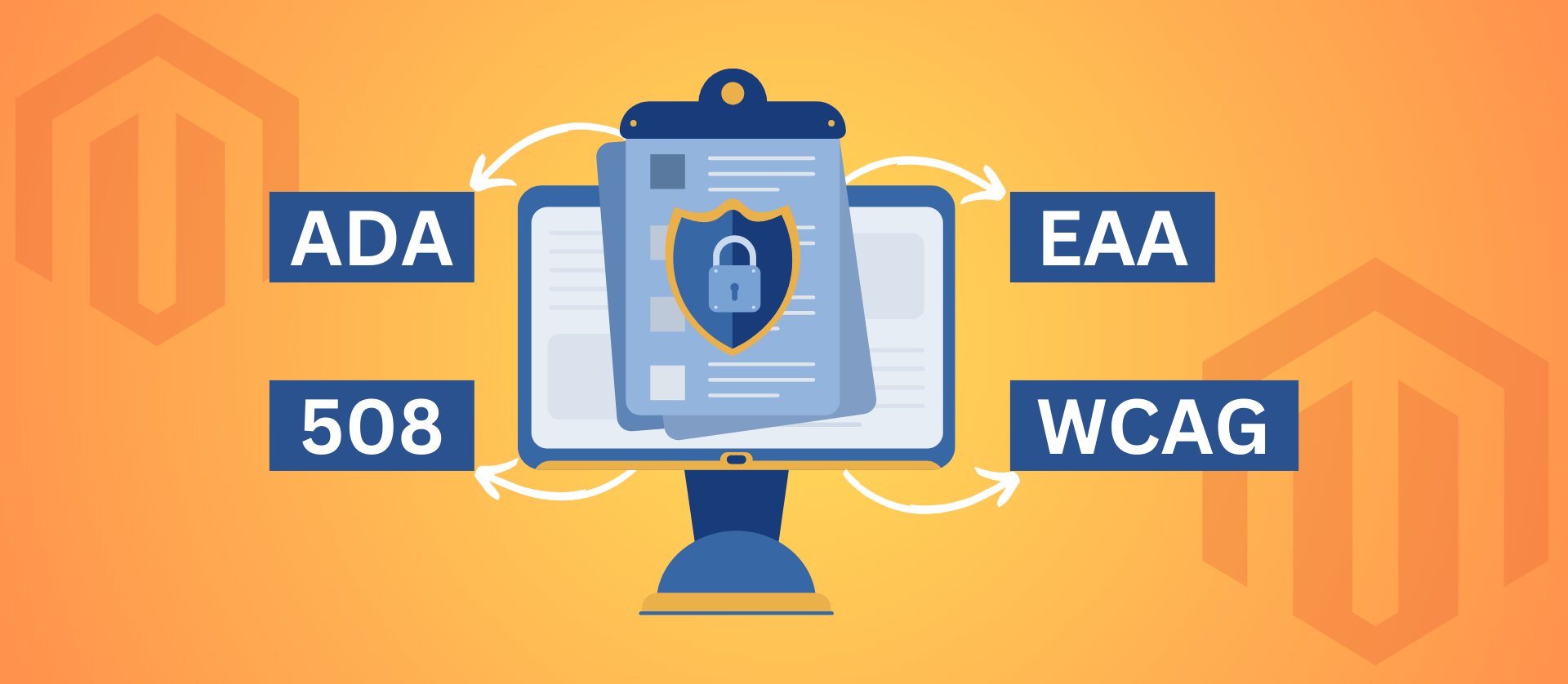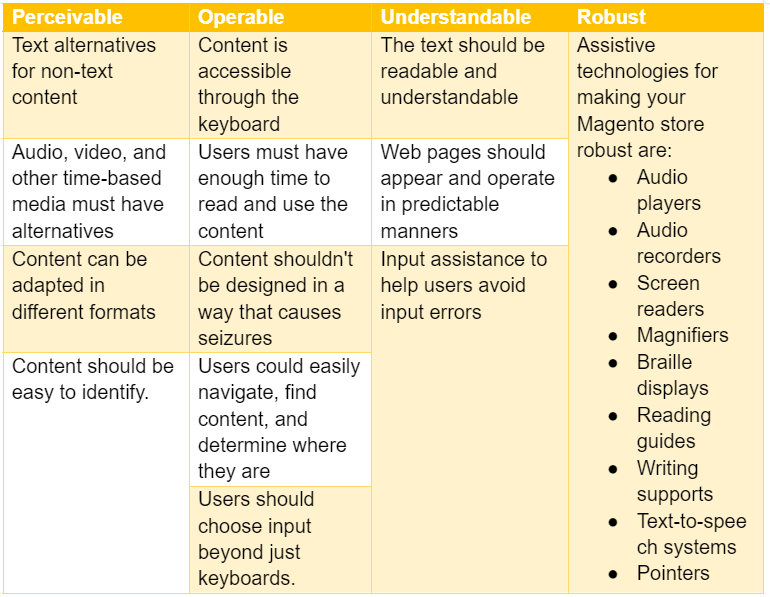
Nearly 43% of the websites have been found to be less accessible than other websites, and it is not surprising that e-commerce websites account for 82% of all website types that regularly face lawsuits of low accessibility. Thus, if you are running a Magento-powered e-commerce store, achieving and maintaining Magento Accessibility Compliances should be a significant concern.
There are many key regulations that your store needs to adhere to. In this article, we will understand all the significant concepts of Magento accessibility compliance. We will also delve into how to achieve those compliances and provide better Magento accessibility practices.
What is an Accessibility Compliance?
Accessibility compliance ensures that your Magento store meets specific accessibility standards or compliances defined in the laws, directives, or guidelines in your country. However, there are four major accessibility laws that apply to e-commerce stores, including the Magento-powered ones. These are:
- Americans with Disabilities Act (ADA): It mentions standards of accessibility of all public businesses
- Section 508: It is an amendment to the 1972 Rehabilitation Act, which mentions standards of accessibility for the websites of government agencies.
- European Accessibility Act: It expands on the Web Accessibility Directive
- Web Control Accessibility Guidelines (WCAG): It mentions web standards and regulatory compliance for the entire IT realm.
It may be possible that your website doesn’t require you to follow one or more of these standards, but following these standards isn’t just about complying with legal standards; you can increase the accessibility of your Magento store for a large audience. Let’s understand these compliance standards in more detail.
ADA Compliance:
In 1990, when the internet was still in its nascent stage, the United States passed the Americans with Disabilities Act, a civil rights law, to protect its citizens from any discrimination. However, now, with so much evolution in the internet, people need access to basic utilities and information to buy products, services, etc. This means every website that deals with the public is ADA-compliant for better accessibility to all people.
The requirements are the same for all large and small companies or businesses. In 2023, 73% of ADA lawsuits have targeted businesses with revenue less than $25 million.
How do you make your Magento Store ADA-compliant?
It is your responsibility to make your store ADA-compliant. Make your store ADA-compliant as soon as possible. Here are the primary requirements to make your Magento store ADA compliant:
- Accessible Website Structure: The structure of your Magento store should be clear and meaningful to the users. Use semantic HTML to provide a proper heading hierarchy for screen readers.
- Focus and Navigation: The navigation flow of your Magento store should be consistent and logical. Thus, every user would be able to identify and navigate through the focusable elements.
- Accessible Rich Internet Applications (ARIA): For better accessibility of dynamic content and interactive elements, use ARIA elements.
- Keyboard Accessibility: All the functionalities of your Magento should be accessible using the keyboard alone.
- Text Alternatives: For content such as images, you must add alt text to images and provide text descriptions.
- Form Accessibility: Make sure error warnings are connected to the appropriate form fields and label form fields using concise and informative language.
- Contrast and Color: The contrast between the text and the background elements should be enough to be easily distinguishable.
- Responsive Design: The Magento store should be responsive across a wide range of devices and browsers.
We understand that you wouldn’t want to spend your essential time making your site ADA compliant but rather on your business activities. We can provide you with the best Magento development services and make your Magento store compliant with ADA rules and regulations.
Section 508 Accessibility for your Magento Store:
The Section 508 amendment of the Rehabilitation Act defines Section 508 as a set of standards that federal agencies should follow while providing their information technology services. The core principles of Section 508 are similar to that of ADA. However, it provides a robust framework for ensuring your Magento store is inclusive.
If your Magento store is meant to be used by federal entities, it must meet the standards of accessibility mentioned in Section 508. The standards are pretty similar to ADA guidelines and are designed to ensure that people with or without disabilities have equal access to and use of information.
WCAG Compliance for your Magento Store:
The World Wide Web Consortium designed and created the WCAG compliance standards. WCAG is the global gold standard for web accessibility on the internet. Most of the considerations of WCAG compliance match with ADA compliance, and in fact, the first step that many companies take for ADA compliance is going through the WCAG guidelines.
There are four major principles of Magento WCAG guidelines around which they have designed. These are also called POUR attributes that define the accessibility:
- Perceivable: Users should be able to perceive content with a sense they have.
- Operable: Users should be able to operate the interface that is presenting the content.
- Understandable: Users should be able to easily understand both the content and user interface through which it is delivered.
- Robust: Multiple user agents should be able to access the content through assistive technology, even though the technology and format standards evolve.
To make your Magento store align with the POUR framework, you must follow these regulations:

Compliance Levels of WCAG Accessibility in Magento Store:
There are three primary levels in WCAG Compliance: A, AA, and AAA, which represent different degrees of accessibility compliance. These levels are actually a scale in which level A represents addressing the most fundamental accessibility features while AAA levels represent the highest level of accessibility compliance. Let’s understand these three levels in a basic detail:
- Level A, i.e., Basic Accessibility: Users with disabilities can access web content that meets Level A criteria. Organizations often begin with Level A compliance to establish a baseline of accessibility.
- Level AA, i.e., Standard Accessibility: Level AA focuses on making the content accessible to a more extensive audience, including people with varied disabilities. It is generally standard to achieve Level AA compliance for websites that want to provide a reasonably accessible experience to a diverse set of users.
- Level AAA, i.e., Enhanced Accessibility: Individuals with disabilities experience an enhanced user experience through meeting Level AAA criteria, which address an extensive set of accessibility requirements. Some websites may find it impractical or unnecessary to achieve Level AAA despite its admirable accessibility standards, as this level involves a comprehensive and detailed approach to accessibility.
Magento Compliance with the European Accessibility Act:
In order to enforce EU accessibility compliance, the European Accessibility Act (EAA) is a complement to the Web Accessibility Directive. Whereas EAA targets both the public and private sectors, WAD, which was implemented in 2016, was limited to the private sectors of EU member states. Like ADA, it also covers a wide range of industries, including banking, public transportation, telecommunications, and other sectors, rather than just e-commerce.
EAA rules have already been integrated into the EU laws and will be enforced by June 28, 2025. Any company having more than ten employees or an annual turnover of more than €2 million must abide by these EAA rules. Also, the EAA itself doesn’t provide any guidelines on how businesses should improve accessibility; the best way is to follow the WCAG AA Level compliance. The WCAG AA Level framework is accepted in most cases for digital accessibility, making it a solid strategy for EAA compliance on Magento platforms.
Is accessibility necessary only for compliance?
Certainly No! There are many other benefits of making your Magento store compliant with these different standards. It is not just about meeting legal requirements but also an important business consideration. You are taking a step forward in providing accessible services to your user base. Apart from the legal obligations, these are the major benefits of making your store accessibility compliant:
1. Showcase Brand Commitment To Accessibility:
An accessible e-commerce store demonstrates the vision of your brand: that your shopping doors are open to everyone. This may not be the typical goal of accessibility, but what harm in showcasing your brand’s commitment to an inclusive world?
2. Better User Experience:
Accessibility adjustments benefit more than just those with disabilities. For example, alt text for photos is beneficial to both the blind and those with sluggish download speeds or shaky internet connections. Similarly, closed captions can help not only individuals who are deaf but also those who want to read and cannot listen owing to a malfunctioning speaker or forgotten earbuds.
3. Expansion of your boundaries:
If your Magento store is not accessible to people with disabilities, you may be missing out on a significant chunk of your sales and a potential customer base. You ensure a more comprehensive range of potential customers can access your goods and services by pursuing accessibility compliance for your Magento store.
Here are a few tips to make your Magento Store Accessibility Compliant:
Although we have mentioned several guidelines to follow to make your Magento store acc,essibility is an ongoing effort. Here are some practices that you can follow to ensure that your Magento store is accessible:
Perform a regular compliance audit:
Compliance with the ADA and other accessibility standards can be difficult and time-consuming to implement. Consider talking with compliance specialists and requesting an accessibility compliance report to guarantee that your Magento website meets all online accessibility requirements.
Stay updated on changes related to accessibility guidelines:
There can be changes in the rules and laws for better accessibility of your Magento store. You must regularly monitor the updates and ensure full compliance to avoid any breaches and reduce the chances of any legal action.
Consult with a Magento Development Company
It will be a tedious task to continuously monitor your store for accessibility standards. The better approach would be to give the contract to a Magento development company that provides maintenance services and looks after every aspect of your Magento store, such as accessibility, speed, security, etc. This way, you can ensure that your store is accessibility compliant and focus on the core business requirements of your company.
Wrapping Up:
In this article, we have gone through several standards of accessibility and how it is imperative to make your Magento store accessibility compliant. At Ceymox Technologies, the best Magento development company in India, we develop Magento stores while adhering to all these guidelines and ensuring that the developed Magento store is accessible to a huge audience. Our developers have vast experience in building ADA, WCAG, etc. compliant stores. Let us know your requirements.
Santhosh P is the Chief Technology Officer (CTO) of Ceymox, bringing over 15 years of experience in e-commerce development and more than 13 years of expertise in Magento. He has completed numerous projects for clients across various industries and regions.He has extensive experience in Magento PWA (Progressive Web Apps), VueStoreFront, and Scandi PWA, delivering fast, responsive, and user-friendly experiences for online shoppers. His proficiencies include:Hyvä Magento speed optimization Magento 2 migration and upgrade Magento extension development Magento mobile development Adobe Commerce development Third-party integration with Magento Magento core functionality enhancement Magento multi-store and multi-website development Magento SEO customization Magento marketplace integration Magento ERP/CRM integration Magento mobile integration (Android, iOS)Santhosh holds multiple Adobe certifications, including Adobe Certified Expert - Adobe Commerce Developer, Adobe Certified Professional - Adobe Commerce Developer, and Magento 1 Certified Developer Plus.
View All Articles